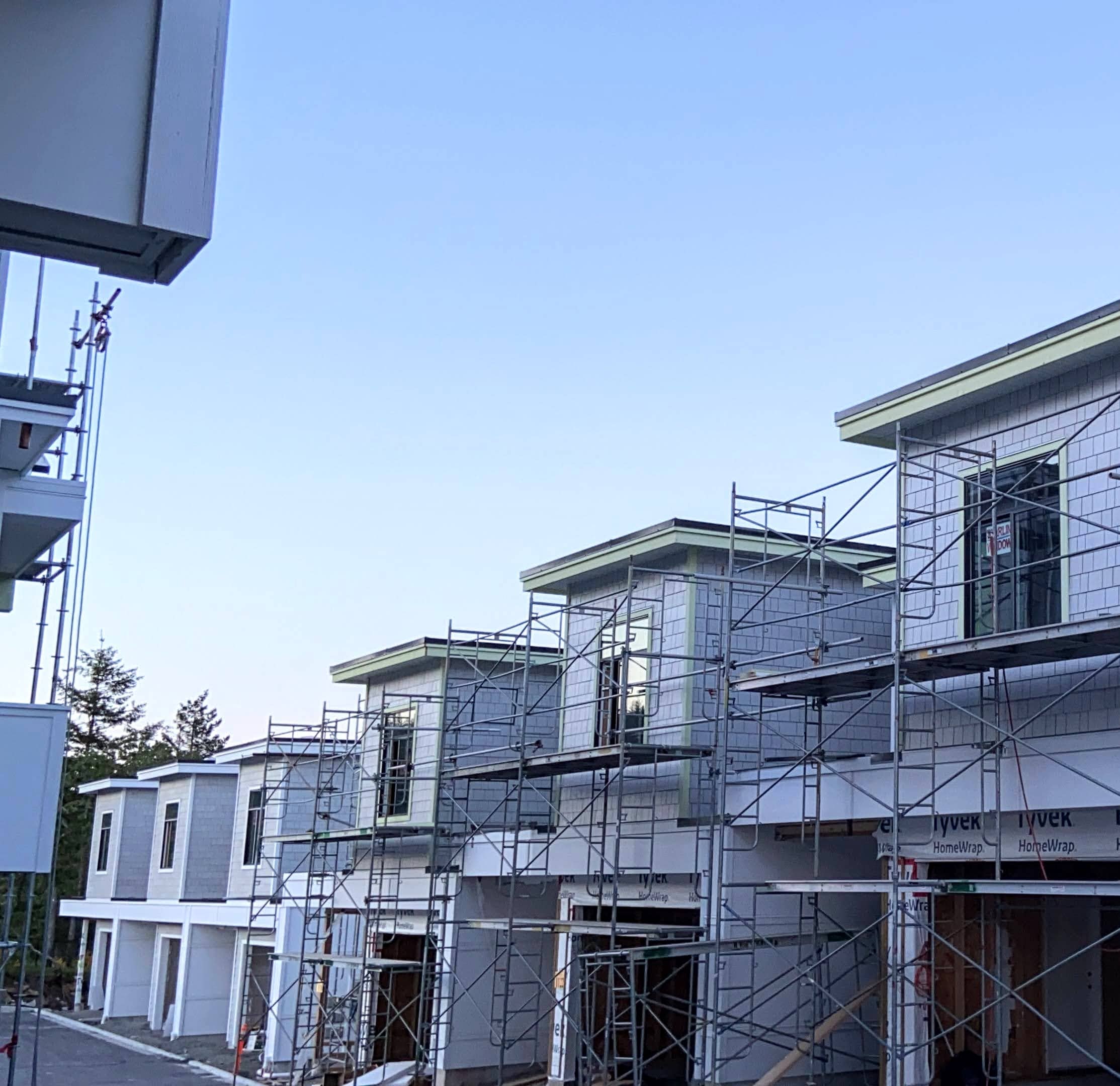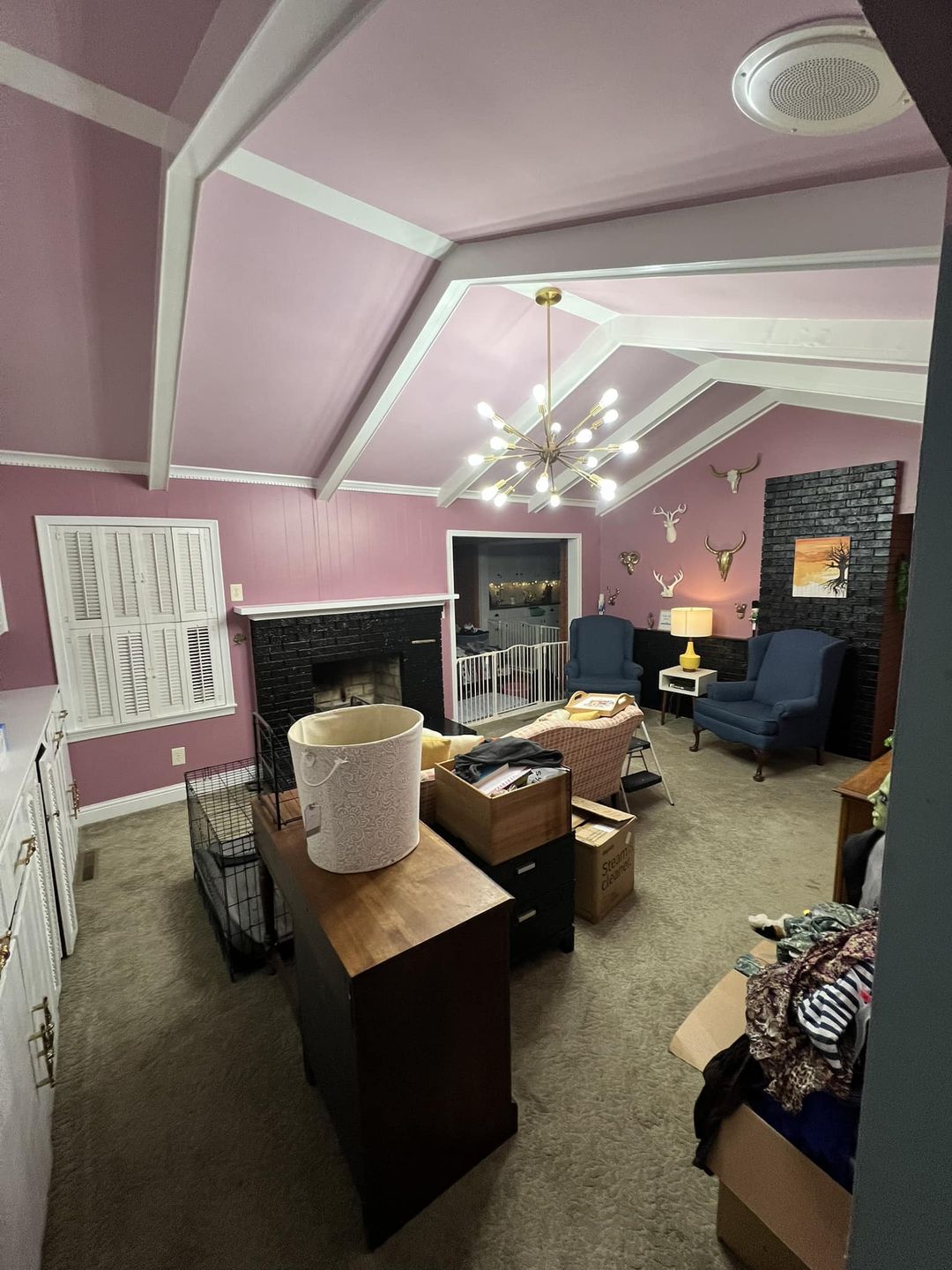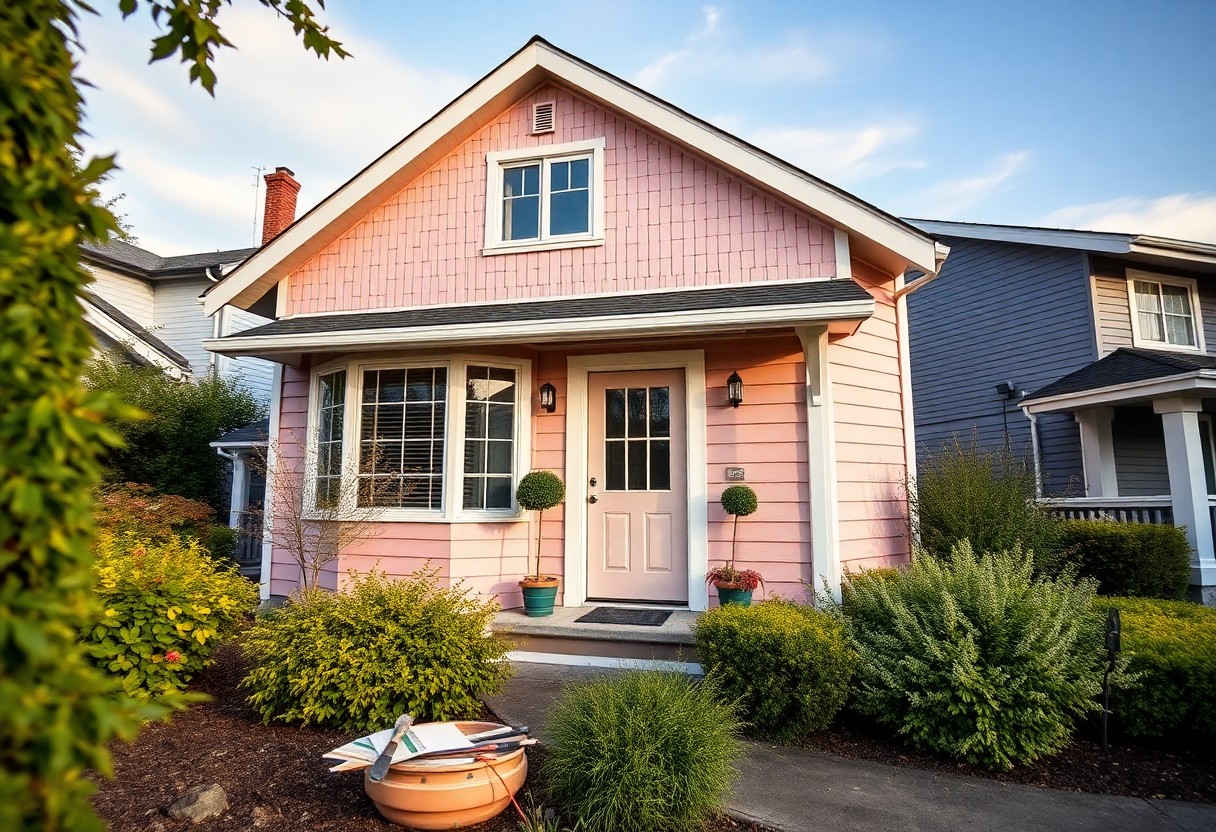Temperature plays a significant role in your stucco painting success, where the ideal range is between 10°C and 30°F.
If you paint in conditions below or above this range of temperature, you usually end up with either poor adhesion, cracking, or even bubbling of your paint.
Living in Victoria, BC – we’re quite lucky. We don’t get the extreme heat and sub-zero temperatures. However, there is a short window of opportunity to paint your stucco siding.
So as you plan your exterior stucco painting project, keep an eye on the forecast and remember to paint in conditions that allow for proper adhesion and drying.
Key Takeaways:
- Ideal Temperature Range: The best temperature for stucco painting is typically between 50°F and 85°F (10°C to 30°C). This range ensures proper adhesion and curing of the paint.
- Avoid Extreme Conditions: Painting in temperatures below 50°F (10°C) or above 90°F (32°C) can lead to issues such as improper drying, surfactant leaching, blistering, bubbling or peeling.
- Humidity Level: Maintain a humidity level of 40-70% for optimal painting conditions, as high humidity can slow drying times.
- Weather Considerations: Avoid painting in rain or on extremely hot days that may affect the quality of the finish.
- Surface Temperature: Ensure that the stucco surface itself is not excessively hot or cold; if it’s too hot to touch, then it’s likely too hot to paint!
Understanding Stucco Painting
The first thing you need to know about stucco is that it’s really porous and you’ll likely need more paint than you would normally use. Proper preparation, including cleaning and priming, ensures the paint adheres well.
The right temperature range when applying paint is vital, as it influences drying time and the overall finish, making it vital for you to understand the conditions before you start your project.
Importance of Temperature
Along with the right paint and tools, temperature plays a significant role in how well your stucco paint job turns out. Here’s a quick breakdown:
| Temperature Range | Effects |
| 10-30°C | Optimal adhesion and drying time. |
| Below 10°C | Increased drying time, risk of surfactant leaching. |
| Above 30°C | Quick drying, may cause blistering. |
Effects of Weather Conditions
Before venturing into your painting project, it’s vital to evaluate the weather conditions. High humidity, rain, or direct sunlight can negatively impact your paint’s performance and application.
Painting during extreme weather conditions can lead to disastrous outcomes, such as unsightly bubbles or uneven textures. High humidity can cause prolonged drying times, while rain can wash your freshly applied paint, ruining all the hard work you’ve put in.
On the flip side, direct sunlight and heat can make the paint dry too quickly, leading to bubbling and blister, and ultimately a poor finish.
Lastly, painting on the shoulder seasons (Fall and Spring) can have shorter of working time throughout the day as the nights and morning are known to be cool.
Ideal Temperature Ranges
Now, if you want your stucco painting project to look amazing and stand the test of time, it’s about nailing the ideal temperature ranges.
Temperature can make or break the quality of your paint job. Here’s a breakdown of what you should aim for:
| Temperature Range | Condition |
|---|---|
| 10°C – 35°C | Optimal for drying & adhesion |
| Above 35°C | High risks of blisters |
| Below 10°C | Prolonged drying time |
*Keep in mind other factors such as humidity, surface temperature and dew point are other factors that affect the drying time.
Recommended Temperatures
About ensuring success, here’s the scoop on recommended temperatures for your project. Keeping things within this range can help your stucco stand strong against the elements:
| Ideal Temperature | Benefits |
|---|---|
| 15°C – 23°C | Perfect for application |
| 24°C – 30°C | Quick drying & setting time |
Potential Risks of Wrong Temperature
Any time you stray from the recommended temperatures, you risk major headaches. Painting in the wrong conditions can lead to all sorts of problems:
| Issue | Description |
|---|---|
| Bubbling | Paint shrinking because of drying too fast |
| Uneven Texture | No leveling of paint, bumpy and rigid. |
Due to the risks associated with temperature fluctuations, you might find yourself dealing with a finish you absolutely hate.
If you paint on a hot day without proper precautions, expect blisters that ruin your hard work. And if it’s too cold, your paint will have difficulty adhering, resulting in an uneven texture.
This is all about ensuring your stucco painting experience is smooth and successful, so keep tabs on that thermometer!
Preparing for Stucco Painting
The foundation of any exterior paint job is the prep, namely the washing. Proper preparation is key to achieving a beautiful, long-lasting finish on your stucco surfaces.
Start by cleaning off any dirt, mold, or loose paint to ensure a solid, reliable basis that your new coat can cling to. A little elbow grease goes a long way, so get ready to roll up your sleeves and examine the prep work.
Surface Preparation
Against common belief, painting over rough or unclean surfaces can lead to disastrous results. Make sure you pressure wash the stucco to eliminate grime and peeling paint, leaving you with a pristine canvas to work on.
Following up with a quality primer suitable for stucco will set you up for a solid bond with the paint, providing that extra layer of protection.
Choosing the Right Time
Painting when the weather aligns just right is your ticket to success. Check the forecast and aim for those sunny days without extreme heat or storms.
Your material needs the right temperature to cure properly, and if you’re battling frigid cold or blazing sun, you could risk unsatisfactory results.
Preparation is all about timing – it can be the difference between painting perfection and a messy, neglected job.
Aim for temperatures between 8°C and 30°C, ideally settling in that sweet spot of 12°C to 23°C. Avoid painting when it’s too hot or too cold; this can mess with the drying process and diminish adhesion.
Also, steer clear of direct sunlight when applying to avoid uneven application. Ultimately, getting the timing right will put you on the fast track to a stunning finish and protect your investment.
Tools and Materials for Success
All the planning in the world won’t help if you’re not armed with the right tools and materials. To achieve that perfect stucco finish, you need to invest in high-quality supplies that can deliver results. Your painting journey will go way smoother with the right gear that can handle whatever challenges come your way!
Quality Paint Options
About your paint choice—it matters more than you think! Selecting high-quality paint designed specifically for stucco surfaces ensures better adhesion, durability, and a vibrant finish that stands the harsh westcoast weather of Vancouver Island.
You want paint that can handle the elements while looking fresh and new!
Stucco Painting Tools
Below are the necessarys you can’t overlook. Having the right tools will massively amplify your efficiency and the outcome of your stucco painting project. You’ll need a sturdy ladder, rollers, brushes, and a spray gun options if you’re feeling bold. Each tool plays a part in delivering that killer finish you crave!
A successful stucco painting project starts with the right tools. Here’s some of the tools you will need:
- A sturdy aluminum ladder is necessary to reach high spots
- A sprayer to apply the paint. (Yes, spraying gives better coverage)
- High quality rollers and brushes.
- Extension poles, drop clothes, etc
We won’t bore you with all the tools, because painting your stucco is hard work! That’s why you should contact us at Xico Enterprises to help you paint your stucco home.
Tips for Optimal Application
Many factors contribute to your stucco painting success, so let’s hone in on some smart tips. Ensure you:
- Check the weather forecast
- Choose the right temperature range
- Use high-quality mildew-resistent paint
- Test your surface for moisture
- Apply in the early morning or late afternoon
Thou shall level up your stucco game with these important tips!
Techniques for Even Coverage
For best coverage apply the paint with a Greco or Titan sprayer and back rolling team. The paint spray machine helps get the paint in all the nooks and cranies of your stucco while the back roller works in the paint and spreads the paint on evenly.
Always apply paint in consistency and layers to dodge those unsightly patches. Don’t rush—take your time and simply enjoy the process!
Common Mistakes to Avoid
Despite having the right tools and paint, many homeowners trip up by making silly mistakes during stucco painting. Pay attention and make sure to steer clear of these common hiccups that can sabotage your hard work.
Overlooking the Weather
For successful stucco painting, checking the weather forecast is non-negotiable. You might think you can paint in a little drizzle or intense heat, but that’s just asking for trouble. Ideal conditions help your paint adhere properly, preventing peeling and ensuring a smooth finish.
Rushing the Process
Common mistakes arise when you rush the painting process. You might be excited to see your stucco transformed, but skipping preparation steps or applying paint too quickly can lead to a mess.
Taking your time allows for thorough cleaning, drying, and even multiple coats if needed. This diligence ensures better durability and a finish you can actually be proud of. Trust us, finishing right is worth way more than finishing fast.
Summing up
With this in mind, you’ve got to nail those temperature ranges for successful stucco painting. If you need help painting your stucco home or would like a free quote, contact us today.
FAQ
Q: What is the ideal temperature range for stucco painting?
A: The ideal temperature range for stucco painting is typically between 10°C and 32°C. This range allows for optimal adhesion and drying of the paint, ensuring a smooth and even finish.
Q: Why is temperature important when painting stucco?
A: Temperature impacts both the viscosity of the paint and the curing time of the stucco surface. When temperatures are too low, paint may dry slowly and could be prone to drips or runs. Conversely, high temperatures can cause paint to dry too quickly, leading to uneven application and poor adhesion.
Q: What should I do if it’s too hot or too cold to paint stucco?
A: If the weather is too hot, consider painting during the cooler parts of the day, such as early morning or late afternoon. If it’s too cold, you may need to wait for a warmer day or use heaters to bring the temperature up in the painting area, ensuring the surface and the paint are within the ideal range.
Q: How does humidity affect stucco painting temperature guidelines?
A: High humidity can impact the drying time of paint and may create challenges such as blistering or peeling. Ideally, humidity levels should be between 40% and 70% for efficient stucco painting. If humidity is high, it’s advisable to check the manufacturer’s guidance on painting conditions.
Q: Can I paint stucco if the temperature fluctuates during the day?
A: It’s best to avoid painting if you anticipate significant temperature fluctuations, especially if they go below the recommended range. Consistent temperatures help ensure that the paint adheres properly and dries uniformly. If fluctuations are expected, wait for a day when temperatures are stable within the suitable range throughout your painting schedule.





